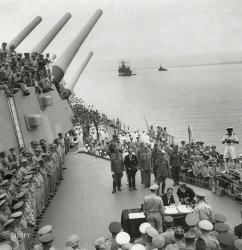
MAY CONTAIN NUTS

Search Shorpy
SHORPY ART

Framed or unframed, desk size to sofa size, printed by us in Arizona and Alabama since 2007. Explore now.
Join and Share
Ad-Free Shorpy
Shorpy is funded by you. Patreon contributors get an ad-free experience.
Learn more.

Recent comments
- Texas Flyer wanted
- Just a Year Too Soon
- WWII -- Replacing men with women at the railroad crossing.
- Yes, Icing
- You kids drive me nuts!
- NOT An Easy Job
- I wonder
- Just add window boxes
- Icing Platform?
- Indiana Harbor Belt abides
- Freezing haze
- Corrections (for those who care)
- C&NW at Nelson
- Fallen Flags
- A dangerous job made worse
- Water Stop
- Passenger trains have right of way over freights?
- Coal
- Never ceases to amaze me.
- Still chuggin' (in model form)
- Great shot
- Westerly Breeze
- For the men, a trapeze
- Tickled
- Sense of loneliness ...
- 2 cents
- Charm City
- What an Outrage
- Brighton Park
- Catenary Supports
Member Photos
The Shorpy
Print Emporium
Print Emporium
Search Shorpy
Search results -- 30 results per page
- Wide Load: 1959
- Aug. 21, 1959, somewhere in New Zealand. "Two women with four small children in a pushchair on a city street, ... could have been taken in Wellington, Auckland, Dunedin or New Plymouth. There must be a Kiwi here who can identify the location! :)
... Posted by Dave - 05/15/2014 - 1:01pm -
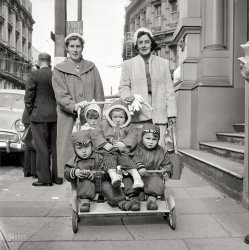
- Old Unreliable: 1921
- New Zealand circa 1921. "Wanganui Fire Brigade's Merryweather fire engine on blocks, probably in Chavannes Garage. When new, the vehicle had a large hose reel, later removed and replaced by rear ... Posted by Dave - 03/13/2014 - 8:56pm -
![Old Unreliable: 1921 New Zealand circa 1921. "Wanganui Fire Brigade's Merryweather fire engine on blocks, probably in Chavannes Garage. When new, the vehicle had a large hose reel, later removed and replaced by rear lockers. A report in January 1926 stated that the machine was useless and unreliable. It was sold a short time later for 60 pounds." Glass negative by Frank J. Denton. View full size.
All the Comforts of HellSix solid rubber tires, a chain drive, all that shiny brass, and no true driver seat. You either stood to drive it, or sat on the board behind the wheel.
I can't imagine why they didn't think this was the most wonderful vehicle ever made.
What a great pictureLine shaft machine shop behind the wall.
Hit and miss air compressor on the lower left.
Jig table front and center.
Modern shop in the day.
Sold for.....60 pounds of what?
[Sterling. -tterrace]
Love those SideshaftsThat stationary engine is a sideshaft and looks a lot like a Tangye engine. Engines with sideshafts are uncommon, and the sideshaft is responsible for operating the ignition of the engine as well as governing the speed.
Kingpin replacementLooks like the boys are replacing the kingpin on the right front wheel. Also notice the plain (non-ball or roller) bearing that the wheel runs on. Plenty of work there for the machine shop on the other side of that wall!
Any more pictures in this series? Sure would love to see some of those machines hooked to all those belts.
Drive mechanism in the background.Notice the pulley drive system in the background behind the wall. I assume they had some sort of machine shop in the back driven by a belt and pulley system.
(The Gallery, Cars, Trucks, Buses, New Zealand)](https://www.shorpy.com/files/images/SHORPY_FL16656034.thumbnail.jpg)
- Are You Ready for Some Cricket?
- ... United States, but cricket is reasonably popular in the New York area. There are about 20 fields in the city and a number more in the ... 20th century. And yes, it is a thrilling game. These New Zealand lads were on to a good thing. I bet that tall chap in the middle could ... Posted by Dave - 09/08/2013 - 2:12pm -
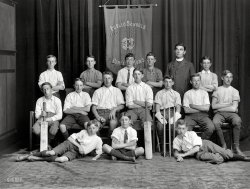
- Minor Heroes: 1910
- New Zealand circa 1910. "Studio portrait of bicycle road racing team with four ... View full size.
(The Gallery, Adam Maclay, Bicycles, New Zealand) ... Posted by Dave - 10/13/2013 - 3:01pm -
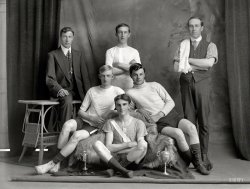
- Gaiety Camp: 1910
- New Zealand circa 1910. "Group men outside a tent with a sign reading 'The Gaiety ... games commense.
(The Gallery, Adam Maclay, Camping, New Zealand) ... Posted by Dave - 12/11/2013 - 11:28pm -
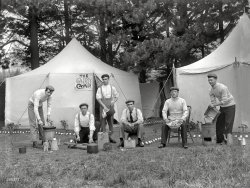
- Class A: 1909
- New Zealand circa 1909. "Class A locomotive, NZR No. 419, at the Petone Railway ... and equipment removed.
(The Gallery, A.P. Godber, New Zealand, Railroads) ... Posted by Dave - 06/01/2014 - 11:10am -
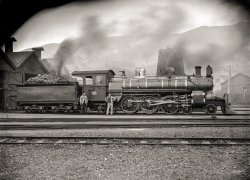
- Kiwi Garage: 1908
- Christchurch, New Zealand, circa 1908. "Wolseley and Cadillac motor cars in garage." Glass plate ... Caddy. Must have been hell on tire wear.
One of my new favorites If only I could get my garage this tidy. Perhaps it is likely ... Posted by Dave - 08/23/2013 - 7:43pm -
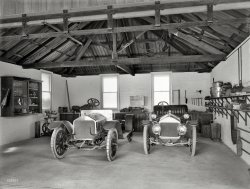
- Take Rheumo: 1890s
- 1890s New Zealand. "Grocery shop interior, with staff, location unidentified." Silver ... to practice the old soft shoe.
(The Gallery, New Zealand, Stores & Markets) ... Posted by Dave - 10/16/2013 - 1:31pm -
![Take Rheumo: 1890s 1890s New Zealand. "Grocery shop interior, with staff, location unidentified." Silver gelatin print, photographer unknown. View full size.
Watch for falling crocksIn the event of an earthquake, the manner in which those groceries and breakable items have been stacked would spell disaster for the employees and their entire inventory of merchandise, never mind if someone thoughtlessly took a can from the bottom row of that tower of tins. Oy vey!
Oh; The Humanity!>>[That's Betty. Betty Crockery. - Dave]
I like the little kittens and puppies in cute little outfits. I can take the WWII cuties playing strip poker. I don't mind the occasional snarky comment from the distinguished moderators.
But the puns! There should be a warning of some sort before Shorpy's gentle readers are confronted with a facer like the above.
--Jim
ChamberpotsThe bowl and pitcher sets appear to have a third component, which I assume to be a matching nightsoil receptacle. I recall seeing only two-piece sets here in the U.S. A difference in style, or maybe the pots were not so desirable as antiques.
Who's that on the right?I think it's a WOMAN! Isn't she supposed to be hiding behind the crockery? And she's smiling! A nice change from those dour menfolk, I say.
[That's Betty. Betty Crockery. - Dave]
What shall I have?A quarter of laudanum, please. Oh, and some arsenic.
Not Much DifferentSave for the crockery, this might be any of a number of US neighborhood grocery stores before supermarkets drove them to extinction. The chairs are for madam to take her ease whilst the attendant fetches each item on her list, one can or packet at a time. Not immediately evident but certainly present are the extension tongs used to grab merchandise on high shelves. Produce and meats would, of course, be sold in other establishments. All that appears to be lacking is the sawdust spread on the floor to absorb spills -- and, of course, to provide bored and impatient five-year-olds the opportunity to practice the old soft shoe.
(The Gallery, New Zealand, Stores & Markets)](https://www.shorpy.com/files/images/SHORPY_FL16810792.thumbnail.jpg)
- Through the Wringer: 1950
- ... Circa 1950 photo by the Gordon Burt studio in Wellington, New Zealand. View full size.
The Stories are True On this day in 1970, I ... Posted by Dave - 08/26/2013 - 9:01am -
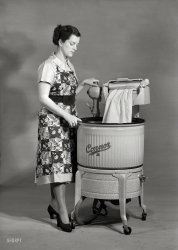
- Outdoor Life: 1910
- New Zealand circa 1910. "Unidentified group outside a tent, possibly at Sumner, ... neither scared nor grim. Although photography was hardly new by 1910, most people had still never been photographed. In addition to the ... Posted by Dave - 09/11/2013 - 10:06pm -
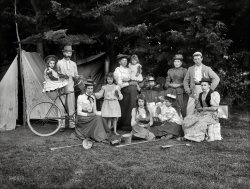
- Young Granddad: 1963
- ... 90s.
There are about 23 boats operating here now. Some New Zealand. With Samoa Packing closing down that number may diminish.
From ... Posted by Tony W. - 09/17/2011 - 8:08pm -
![Young Granddad: 1963 This is my dad as a toddler with Grandpa washing the car, probably around 1963 in Los Angeles. Scanned from a Kodak safety negative. View full size.
Hunky GrandpaSimply cannot ignore this perfect-looking gent. This appreciative female thanks you for remembering that ladies enjoy a gorgeous view, too.
Hubba HubcapHey, Grandpa was good lookin'!
A choice specimen indeedThe Volvo, I mean.
PLCF CenterfoldThe Rambler, the Volvo, Junior's sandals -- this could be cover art for the Summer 1963 issue of Progressive Left Coast Family. What did your dad end up doing as a grownup? What was Granddad's line of work? A great photo, very evocative.
A Rambler *and* a VolvoWow, a Rambler Classic, *and* a Volvo (looks like a 544) in the same driveway. And your dad is about my age (49). Great picture. Thanks for sharing this one, Tony. When I was a kid, my parents owned a Rambler, and my dad was always fascinated with Volvos, mainly the 122.
Wow!Reminds me of Don Draper. Yum!!
OH MYGrandpa looks mighty fine!
They don't make 'em like that anymore!Chain link fences that is... Notice the top of the fence. Those barbs opened up the wrist of my friend when we were kids back in Newark NJ in about 1960. There were hedges behind the fence and he reached over while passing by on his bike to pull off a leaf. Zzzziiippp. Several hours and a spools worth of sutures and he was okay. Thankfully, fence tops are folded over now.
Gangster WhitesI had just gotten my driver's license in 1963 and I remember cleaning whitewalls with a Brillo pad, just like Grampa is doing.
ApexThe absolute apex of American civilization captured in this photo. That's it folks. It'll never happen again.
And for dessert I'll haveAn order of beefcake, circa 1963!
Hubba hubba!Grandpa can hang his hat at MY house ANY time!
I cringedIt's odd to read all these lustful comments about my grandpa, but hey, whatever floats your boat!
My grandpa was (and still is) a chief engineer on tuna boats.
My father also became a chief engineer on American tuna boats, first starting in San Diego and then moving to American Samoa. Now he works in the ports and gives his wealth of knowledge about engines to other engineers.
To put it bluntly, he's the guy who makes sure boat engines run well enough so you can have a tuna sandwich.
Re: I cringedThe cougars do get restless around twilight -- if you don't turn your back on them you'll be fine. My favorite thing here is the bright yellow hose on the green lawn. Something tres Sixties there. You have a good eye for interesting pictures.
Pago PagoGreat photo. I probably know your dad (and granddad) as I was here in Pago during the great purse-seiner days of the late 1980s and through the 90s.
There are about 23 boats operating here now. Some New Zealand. With Samoa Packing closing down that number may diminish.
From Pago Pago,
John Wasko
Yellow HoseSeeing the yellow water hose reminded me of how my father and uncle, back in the 50s and 60s, would never buy common "garden hose" (like we still have) because it wore out much too quickly. One kink and it's dead.
Rather, they would buy low pressure air hose, like the kind used in gas stations. Ten minutes with a hammer and you had a sturdy hose, typically yellow or a dull red, which was probably 25 percent more expensive but would last for years. I still have one I made back in the 70s and use often.
HVAC UpgradeNote the window A/C next door. These "breeder boxes" were built hurriedly (but solidly) throughout SoCal by the hundreds of thousands in the years following WW2.
Built-in A/C was a practically unheard of option in these houses, but by 1963, even my grandparents had it (courtesy of Sears). My gramp got spiffy and cut a hole in the wall for their unit.
Grandpa was such a beefcakeI bet the son and the grandson became great hunks too !!
Perfect sandals!Love the sandals on the toddler! Those were the days when sensible people designed sensible summer footwear for children--not the slide-ons you see today.
HotnessI sure am glad it was a hot day!
There are plenty of things I could say right now...But I think a dreamy sigh will suffice.
Stylin'I love how the baby looks so ...tidy. His hair was parted and combed over, just to go outside with Daddy and wash the car. For a candid snap, this is remarkably poised.
One more thingI wanted to make one more comment. Someone mentioned above that this reminded them of the "apex of American society". Interesting in that if you look at how most Americans lives back in the 50's and 60's, the typical family had a house that was around 700 square feet, a single car, and a single TV set. My mother along with most everyone else in my family grew up in small houses like those shown in the picture. They also shared rooms with their siblings.
Look around today and the typical family home is over 3,000 square feet, there are at least 3 cars in every driveway, at least 2-3 TV sets ( flatscreens) at least 2 computers, a cell phone for every family member, an abundance of shoes and clothing which are bought as cheap disposable items at big box stores, and other endless forms of entertainment. Yet when people speak of "the good times", somehow we always come back to this single era. I think that says an awful lot about the lack of appreciation people these days have for what they've got. My grandparents went through the depression and WW2. 15 years of pain and suffering. You had better believe they appreciated everything they had after it was all over. Even today with the worst recession in decades, I doubt most Americans come close to that level of appreciation.
TouchingI LOVE this picture. it really put a smile on my face for so many reasons.
The Good Ol' DaysGregg Easterbrook wrote a book, "The Progress Paradox," discussing how people in the U.S. and Europe today are living better than their parents ever did, yet aren't any more happier. Just because we have more things like cell phones, TV's and cars, doesn't make life truly any better. OTOH, if you asked the people of the period in this picture if they thought this was the Apex of American Civilization, you may get a surprising answer. They may have thought life was so much better back in the Twenties or something, where they didn't have to worry about Communist missiles, civil unrest, or atomic radiation causing giant ants to run amok.
And yes, Grandpa is mighty fine. Mighty fine. Is he still alive? Is he aware of how much drool he's engendered?
P544I had a P544 bought new in 1964 with the only options available, a $5 side mirror and a $35 AM radio, $2,050 complete.
A VW at the time sold for around $1,295.
Had to crack open a window to close a door, airtight.
The 122 was nice as well, but the P444-544 was a true classic.
Young father and grandfather!If the toddler is your father in 1963 he married VERY young to have you! And you are very young.
[His dad could have been around 40 when he got married. If you click on Tony's profile you'll see that he is 18. - Dave]
Color MagicI love Shorpy. Work today was very slow so, um, I sorta spent the last half-hour Shorpy-ing. The older, b&w photos are intriguing but it's these color images from the 1960s that have really caught my imagination today. Color just sorta has a "you are there" effect!
So, anyway, thank you Tony and TTerence for sharing these! And, I know you think this is weird Tony, but I have to agree that Grandpa was/is mighty fiiiiiine!
'61 Rambler, 60-something P544My parents also had this same combination of cars, a '61 Rambler and a 1960 Volvo P544. I think the Volvo cost about $1800.
You are fortunateI love this picture, I was admiring all of the details and your grandfather was quite a handsome man. I was never fortunate to have met either of my grandfathers, so I am quite jealous. It also takes me back to my childhood.
GrandpaOh why do we have to get old.
SurprisedI just looked around this site, first I saw my mother (Baby Shower 1960). My kids laughed and said look at the rest, Dad! I am the kid with the yellow hose, cowboy tricycle etc., and this is my dad. Ladies, you are right! He was, and still is, a "super hunk" -- 72 now, and I am 49.
Great job son,
Love Dad
Oi!Now that's a real life Charles Atlas!
(ShorpyBlog, Member Gallery, Handsome Rakes, Tonypix)](https://www.shorpy.com/files/images/WashingtheCar_0.thumbnail.jpg)
- Happy Birthday Shorpy!
- ... are mourning the loss of 29 miners in a mine explosion in New Zealand. I think it is fitting we remember Shorpy and all the nameless ones ... Posted by Dave - 08/15/2012 - 9:56am -
![Happy Birthday Shorpy! December 1910. "Shorpy Higginbotham, a 'greaser' on the tipple at Bessie Mine, Alabama, of the Sloss-Sheffield Steel and Iron Co. Said he was 14 years old, but it is doubtful. Carries two heavy pails of grease, and is often in danger of being run over by the coal cars." Photograph by Lewis Wickes Hine. View full size.
Shorpy was born 114 years ago on November 23, 1896. After this photo was taken, he lived 17 more years until he died in a mining accident at the age of 31. This Thanksgiving, let's raise a toast to his too-short but memorable life.
Happy birthday ShorpyHappy birthday!!! You are not forgotten
Shorpy rememberedWhat a singular thing it is for an otherwise forgotten life to be remembered, even memorialized, this way, via Shorpy, the site. Combined with that, the poignant story of Shorpy the person, his childhood and abruptly shortened life - I gotta say, it brings a tear to my eye.
Happy Birthday Shorpy!Shorpy is one day older than my Dad who was born 11-24-96 and died on 1-24-64.
Another milestoneNext month will mark the 100th anniversary of this picture and the other photos of Shorpy taken by Lewis Hine.
I wonderif Shorpy was related somehow to my 6th grade teacher Mr. Higginbotham, because I remember thinking what an unusual name he had and had NEVER met anyone who had a name like that ... until now!
You do honor to his memory.And thank you for running an important historical site.
Shorpy, we celebrate your birthday,Yet we are the ones who receive the gifts, not just once a year, but every day that we visit this always interesting and sometimes incredibly moving blog that Dave created and named for you.
Thanks to you both and here's to another year.
Here's to Shorpy - The hard-working young man, and the fascinating website. Cheers!
Happy Birthday and Cheers Shorpy I think it's great that Shorpy Higginbotham (by the way, I know a Higginbotham) is remembered presently as the name and face behind this site that shares our history through "family photographs" for us to enjoy and enrich each other with our posted comments.
I hope any one of us has this remembrance decades after our passing.
Happy Thanksgiving everyone!
Remembering ShorpyDown here in the southern hemisphere we are mourning the loss of 29 miners in a mine explosion in New Zealand. I think it is fitting we remember Shorpy and all the nameless ones like him.
www.rwyoung.com.au
Possible genealogyI think I've found the 1900 Census record for Shorpy:
His real name was Henry.
Unfortunately the name has an inkblot over it but all the details work out. His father was a miner. He would have been about 3 years old in 1900, and lived in Graysville, Jefferson Co., which is where Bessie Mine is.
[His birth name was Henry Sharpe Higginbotham. The basic facts of his life are recounted on Shorpy's Page. Scroll down for the genealogical details. - Dave]
Thank You ShorpyFor being there every day ... Thank you Dave for this fantastic website. I wish we had one like this in the Netherlands. Very pity we don't. May you live on forever and ever. It would be nice if Shorpy H. could see these beautiful photos on his own PC up there in Heaven!
Happy Birthday ShorpyThanking God today that children don't have to endure what Shorpy did. Yes, I realize children were tougher then, but life was so dangerous. Thanks Shorpy for your legacy.
A toast from meRaise your glass to Shorpy
Who worked at Bessie Mine
He lives on in our memory
Because of Lewis Hine
Happy Thanksgiving, Shorpsters
A glass for ShorpyAnd I don't even drink.
There is much that is haunting about many of the photos that you post, but especially Shorpy's. I'd like to think that somewhere, somehow he's aware of this site and marvels that people know and remember him a hundred years later.
Happy Birthday Shorpy!And many thanks to Dave for always providing a great way to start each Morning with visions from the past!
Happy Thanksgiving to all!
Recognitionof Shorpy's lot in life serves to enlighten all of us of with unvarnished looks at the way this country developed. Thanks to Shorpy (who might be a relative) and all who make this site the success it's become.
No Joy in MudvilleIt is true that the future of these innocents was inevitable if they were born into the mineworkers' families in small towns and hollers in which mining was the only work available. There were few choices and to earn a living, they just had to 'man up', take the high risk jobs of (literally) backbreaking labor, accept that any day could be their last and were glad to have any job. These strong and courageous men and boys were not seeking fame and admiration, just struggling to support their families and do their jobs well. Like many people, even today, they were probably considered "nobodies" by the upper crust of society but to their families they were saints and saviors. My mom told me that when her father finished his day at the mines and walked home, his wife had a warm bath ready (with hand-carried, stove-heated water), then started every meal with soup (to clear out the throat and lungs of soot) and made it clear that he was appreciated by his kids all helping and serving him. I can't speak for everyone but in his case, they never got wealthy (owed their soul to the company store), suffered many family tragedies and his work-related injuries stayed with him for life. Things were so different then, it is hard to believe it was just about 100 years ago, but people truly struggled to survive. We don't know how lucky we are today. Happy birthday Shorpy, we hardly knew ye.
I never realizedin all the time I've spent here, that the site was named for a real person. Thanks so much for giving us this great place to visit and expand our views of history, and special thanks to Shorpy himself.
One for ShorpyI will raise a glass high and take a long drink in his honor.
A question for Dave or Ken. What prompted you to choose Shorpy's name and face for this site?
[The three photos of him just reached out and grabbed me for some reason. Poignant, I suppose. And the name "Shorpy" was appealing -- unique as far as Google was concerned (just one hit), and available as a domain name. - Dave]
Daily remindersEvery day, without fail, includes a visit here.
Young Henry Sharpe, aka "Shorpy," looks out at me every time as a reminder of my blessings. I do hope he had some in his short life.
Another lowly worker, of a different kind, Green Cottenham, brought through exploration of his life a detailed look at oppression, in Douglas A. Blackmon's unforgettable book, "Slavery by Another Name."
I am grateful for the images I see here each day, which serve to reinforce the great faith and effort to achieve true freedom and justice in this country.
I am more grateful for the support which makes this site continue its important contribution to the understanding of what we had, what we have, and what we still must achieve; and for authors such as Mr. Blackmon, who "keep going," to bestow honor on the lowly heroes of our past.
Happy Birthday ShorpyGotta say, when i was 20, I was out partying, now that I'm 50 I've found a better way to spend my nights, and that's with you dave, and especially SHORPY.
Shorpy Higginbotham's story This is Joe Manning, of the Lewis Hine Project. For Shorpy readers who haven't seen it, here is the sad story of Shorpy Higginbotham.
http://morningsonmaplestreet.com/2014/11/26/henry-s-higginbotham-page-on...
Little MenThere's a heartbreaking lot of little men in this picture. Look at those expressions. It was a different world, and we have it way too easy, now--for which I am thankful!
Thanks for the site, Dave. It was an inspired idea.
Happy Birthday Shorpy!I love the great history of the U.S. Thanks for the site.
Land of Equality Who says that America isn't integrated???
Glad to know nowthat this excellent website is named after someone who would have otherwise been forgotten by history. I find Shorpy's story fascinating and the website a great part of my every day. Thanks for this site and keeping Shorpy's memory alive. A guy who worked hard and served his country.
Lunch is on meShorpy is my lunchtime friend. When the the boss comes around, invariably when I'm eating al desko and asks what are you doing, I answer either "a BLT" or "Shorpy."
Salute!All my respect goes to the hardworking miners of the world.
Always center stage.I can't help but think that although he was short of stature, he was someone to reckon with. Everytime he's in a picture somewhere, he is in the middle of the picture.
A real handful. The strange things you deduct from pictures.
Happy birthday Shorp!
Happy Birthday, Shorpy!This was a rather poignant entry, Dave; thanks for all your fine work on here. Shorpy and I share the same birthday, and had his luck been better he probably would have been alive when I was born in 1959 on what would have been his 65th birthday. I think it is wonderful that an ordinary hard-working guy is memorialized on this site, and I hope he's is aware of it, somehow, somewhere, and is amused by it. I also hope that short and hard as his life was, that Shorpy had moments of joy and laughter that outshone the tough times. Happy 114th, Shorpy!!
Training, sort of?Not trying to justify the working conditions that Shorpy and his pals had to work in, but I guess it was good training for the trenches of France where many of these guys would be a few years later. Heck, one might say that Army life was a vacation compared to day-to-day at the Bessie Mine.
Thanks to Shorpy for his inspiration and to Dave for taking the ball and running with it.
(The Gallery, Kids, Lewis Hine, Mining)](https://www.shorpy.com/files/images/01099u1.thumbnail.jpg)
- Toys & Fancy Goods: 1896
- ... here on Shorpy. -tterrace]
(The Gallery, Kids, New Zealand, Stores & Markets) ... Posted by Dave - 11/08/2013 - 9:39am -
![Toys & Fancy Goods: 1896 "Elson chemist and Dutton bookshop on Courtenay Place, Wellington, between 1896 and 1897." Glass negative by Frederick James Halse. View full size.
Phone wire junctionI count 13 crossbars on the telephone pole at the right side of the building. One or two more may be out of viewing. Most that I remember seeing in Shorpy pics.
Lovely wiresThe telephone wires and their poles are so neat and orderly. That probably changed for the worse when they got electric power a few years later, at least if the photos of American towns in the 1900s are any guide.
SignageMaybe I am being extra dense today, but the signage seems to violate grammatical parallelism at the very least. And what's with the full stops after each word?
[The use of periods in signs was a common practice of the time. There are numerous examples here on Shorpy. -tterrace]
(The Gallery, Kids, New Zealand, Stores & Markets)](https://www.shorpy.com/files/images/SHORPY_FL7782736.thumbnail.jpg)
- Ironmen: 1905
- ... collections of the Alexander Turnbull Library, taken by New Zealand Railways employee and amateur photographer Albert Percy Godber ... blastpipe and smokestack.
(The Gallery, A.P. Godber, New Zealand, Railroads) ... Posted by Dave - 06/01/2014 - 12:21pm -
![Ironmen: 1905 Petone Railway Workshops circa 1905. H class steam locomotive, 0-4-2T type, for use on the Fell system on the Rimutaka Incline. NZR 199 built at Avonside Railway Workshops in 1875, went into service on the Rimutaka Incline in January 1877, written off and preserved in March 1956.
One of more than 2,000 train-related glass negatives, now in the collections of the Alexander Turnbull Library, taken by New Zealand Railways employee and amateur photographer Albert Percy Godber (1875-1949). View full size.
Sure built them wellI'd have to say, 79 years of service is pretty remarkable.
Personal BestI've been in service since 1934 -- that's 80 years!
Lumpy LocoAll the sheet metal looks shiny and smooth except for the cab sidewalls. It looks as if it was attacked by a massive hailstorm, or did the crew have a coal-throwing melee?
[Parking lot door-dings. - Dave]
Service LifeIf you have a machine shop and a foundry, you can keep a locomotive like that going practically forever. Of course, after a long enough period, the only original part on it might be the number plate.
Double StacksA feature normally seen only on locomotives with four cylinders and double sets of drivers: mallet, simple articulated, or beyer-garret types, all of which are far larger than this tank engine. In this case each cylinder had its own exhaust nozzle. Strange. Well maintained machine, I give it that.
H classWikipedia has the history. The reason that the H class lasted 79 years was because they were unique; using the Fell system to propel trains over a 1:15 incline. The end came in 1955 when the Rimutaka tuneel was built.
Much more to discoverThe Loco has Stepenson gear - not uncommon 1875, but almost obsolete in 1956. The Loco seems to be under steam. It seems, that steam is coming out a source in front of the cab. Has anyone here seen a H class from near: Is there a safety valve or any other steam outlet on this place? Near a working safety valve nobody would stood so relaxed.
80 Years of service is for a well-maintained steam loco not uncommon. In Germany (Isle of Ruegen) there are several engines this age still in all days use, and in Romania (I've been there several times in the 90's) I also met engines built by Krauss Linz in the 1890's.
The dents in the cab could come from something rude loaded fuel.
Dents in cabAfter thinking long and hard, I came to the conclusion that the dents in the cab side panels were put there deliberately to stop the panels vibrating when the loco reached speeds that achieved resonance in them. Imperfections such as dents break up resonances in large flat panels.
Long service lives, double stacks...79 years in service is nothing unusual for a steam loco outside the US. When I started my apprenticeship I was working on engines that were all close to 100 years old. As ElViejo notes, if you have a well-equipped, well-staffed workshop you can keep them going for a long, long time.
As for the double smokestacks, Lost World is incorrect in saying that only 4-cylinder articulated engines were normally fitted with these. Many modern rigid engines in the US and the rest of the world had them, to improve draughting and reduce cylinder back pressure. Union Pacific 844 is a good example. And as for Garratts, the only examples to have double smokestacks were the Algerian passenger Garratts, and the related engines in Senegal and the Ivory Coast, all built by Societe Franco-Belge. All other Garratts had single stacks.
H199 has double stacks because it has two independent sets of cylinders, one for the adhesion engine, and one for the Fell system grip wheels. Each set of cylinders had it's own blastpipe and smokestack.
(The Gallery, A.P. Godber, New Zealand, Railroads)](https://www.shorpy.com/files/images/SHORPY-FL16666350.thumbnail.jpg)
- A Good Catch: 1910
- ... hoping some of the NZ pictures showed some Maori!
(New Zealand) ... Posted by Dave - 09/29/2013 - 8:47pm -
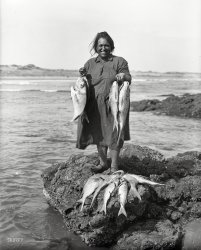
- All the Comforts of Home: 1915
- ... Great old photo!
(The Gallery, Adam Maclay, Camping, New Zealand) ... Posted by Dave - 10/19/2013 - 12:11pm -
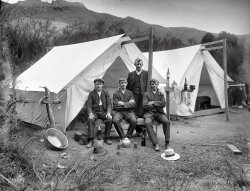
- Imbeciles, Morons, Idiots: 1913
- ... of Diagnoses of 1,000 Cases") from the Sept. 28, 1913, New York Times article linked here .
Outdated? Not reallly... Wow, ... "James Flynn, a philosopher and I.Q. researcher in New Zealand, has established that in the Western world as a whole, I.Q. increased ... Posted by Dave - 06/30/2009 - 12:27pm -
![Imbeciles, Morons, Idiots: 1913 Related to discussion of this post is the pie chart above ("Results of Diagnoses of 1,000 Cases") from the Sept. 28, 1913, New York Times article linked here.
Outdated? Not reallly...Wow, great old NYT article! Sure, we chuckle at the terms (idiot, imbecile, and moron) used in the article and accompanying graphic, but in those days, these were true clinical terms that were not used in the pejorative.
What is really telling is that people in 1913 were not afraid to recognize that an average classroom of children constituted an entire continuum of intelligence and ability. We've got the same thing now... that doesn't change. The difference is that then, they largely ignored the slower kids for the sake of the smarter ones. Today, the exact opposite is true! We dumb down the standards for the smarter kids to "leave none of the stupid ones behind".
One quote from the article says: "A tiny cinder in the eye will entirely incapcitate a man, so one [deficient] child may disorganize and retard the work of a whole classroom."
Ugh, why can't we see this today??? Our government schools spend more of their effort teaching to the dullest in the classroom and the nation suffers by never challenging its best and brightest sufficiently.
Org. ChartI thought this was the official White House organizational chart.
Goober Pea
Implausibly high numbersThe NYT article's header is telling: "NEARLY 15,000,000 SCHOOL CHILDREN ARE DEFECTIVES"
15 million kids -- in a nation whose population at the time was just under 100 million -- is an unrealistically high number. Assuming a 50% population of children, that puts the number of "defectives" at 30 percent.
This might be what Gould was referring to in his The Mismeasure of Man, when he suggested that IQ testing is not a valid means of assessing intelligence and is, more often, simply a political or social-manipulation tool.
Hey lookIt's a list of the people I work with.
Clinical termsYes, those were clinical terms once, but they became perjorative, and a euphemism like "mentally retarded" had to be coined.
Then that became perjorative and "mentally challenged" was made...
NormalConsidering that a lot of people drank a lot back then and that no one knew about fetal alcohol syndrome, it wouldn't surprise me that that quite a few rather dim children were born in those times.
But I'm concerned about the 21 who are "not feeble minded" and "normal." How did they get stuck in that "Clearing house". And how do they get out?
I'm more curious about whatI'm more curious about what "Morally Helpless" means.
Outdated? Yes really...The reason we don't "weed out" the "dullest" students is because it's unfair to ostracize children with mental or educational issues. Isolating them away from the "good" children creates a situation where low intelligence equals outcast. As there is a wide spectrum of intelligence -- you said so yourself -- any line drawn to determine who needs to be isolated and who can stay in a classroom will necessarily be arbitrary.
Anyway, the idea that "kids these days" are getting dumber is just alarmist rhetoric. It doesn't take much work to find articles and studies online which show IQ hasn't changed in any significant way except in regards to how it's tested (I believe we're on Weschler IV now; the standard test used to determine childhood IQ gets "normed" every 15 or so years.)
[Actually, IQ seems to have been trending up over the past few decades: "James Flynn, a philosopher and I.Q. researcher in New Zealand, has established that in the Western world as a whole, I.Q. increased markedly from 1947 to 2002. In the United States alone, it went up by 18 points." (New York Times, December 9, 2007). Wikipedia link on the Flynn Effect. - Dave]
FailureWhile I agree with the point that isolating would be arbitrary (both hard to define and somewhat morally queasy), I think that less is demanded from school-age children now then ever which is the point of the previous poster. I don't see how that's good in any way. I know a lot of teachers (brother-in-law is one) and it's almost mandated that they can't fail anyone. Do kids fail? Sure, but it's hard to do even when warranted.
Why do we do this? So that feelings aren't hurt and the child/person doesn't suffer emotional 'trauma/stigma'. Part of this is the system that says emotional well being is better than anything else (the you're ok, I'm ok philosophy) and the other part is the fear of consequences by upset parents. The problem with all this is that when they get into the real world that doesn't give a rip about how you 'feel' and fire your butt for underperforming, it's twice as bad. Everyone starts to get a sense of entitlement instead of becoming stronger through the struggle.
WowIt's an organizational chart of company directors!
Does it make sense to haveDoes it make sense to have the caravan move at the speed of the slowest camel? Having mentally disadvantaged children in the same classes as the normal ones can only make the unfortunate ones feel incompetent and unhappy. Where I live (Rhode Island) we have schools for such children, who often accomplish more than would be expected from them in regular schools. They are in no way made to feel inferior and are educated with encouragement and praise.
Idiots, Imbeciles etc.I am not sure what "morally helpless" means, but I think I'm in that group.
Sub-moronBack in 1966, when I was 9, I took an externally-administered IQ test with the rest of my Grade 4 class in Winnipeg. I gave it no heed, since a stranger and not our regular teacher was giving us this test, so I answered no questions and simply doodled in the margins. Nothing came of it. Years later, some friends of mine were working in the school over the summer and they snooped in the files and came upon our Grade 4 IQ test scores. Imagine their slobbering pleasure when they found I had scored a 70. On various scales, I could have been classified as a borderline defective, dull, feeble-minded, or well below average, but my official classification at the time was sub-moron. A simple moron would not do. As it turns out, I cannot be executed for a capital crime in the US, so I suppose there are some minor advantages. I now have a nephew with learning and behavioral difficulties who has been labelled many things at school and in the doctor's office, so he takes especial delight in his uncle who is a sub-moron. Even the mention of the word submarine will set him off on a gleeful round of abuse directed at Uncle Sub-Mo.
(ShorpyBlog, The Gallery, Curiosities)](https://www.shorpy.com/files/images/imbeciles-morons-idiots-chart.thumbnail.jpg)
- Dude on the Tracks: 1926
- ... Junction on the east side of the District, to the new resort of Chesapeake Beach, Md., 32 miles, in the late 1890's. It was cut ... - Dave]
Shorted In coronavirus lockdown in New Zealand; is this a method of alerting train drivers to a person touching the ... Posted by Dave - 03/25/2020 - 3:52pm -
![Dude on the Tracks: 1926 June or July 1926. Washington, D.C., or vicinity. "NO CAPTION [Man lying in front of train on tracks]." Perhaps some diligent Shorpysleuth can figure out what's going on here. 4x5 inch glass negative, Harris & Ewing Collection. View full size.
Safety demoI suspect that the guy lying down is demonstrating that the signal voltage is not enough to electrocute him.
Putting signals on this backwater railroad may have been an experimental or demonstration installation to sell the design, without tying up a main line. Of course, this disregards the fact that his shoes are something of an insulator.
Chesapeake Beach RailwayWe are looking at one of two ex-Pennsylvania Railroad locomotives that were numbered CB no.3 (not at the same time, of course). The fluted steam dome with the pair of safety valves visible directly behind the head light is unique to PRR, and helps verify its identity. Disposition of the former PRR engines is unknown.
Chesapeake Beach Railway was opened from Chesapeake Junction on the east side of the District, to the new resort of Chesapeake Beach, Md., 32 miles, in the late 1890's. It was cut back to Seat Pleasant, 3 miles, and renamed the East Washington Railroad in 1935.
As an aside, I was working the B&O local through Chesapeake Junction in Feb., 1978 when we were ordered to enter the EWRR to pull an empty boxcar out of a warehouse on their tracks. We thought that was very unusual, until the next morning we saw the EW connection switch was spiked and that railroad was out of service. I made the last common carrier move on this railroad.
Oh, and as for what is going on here in the photo, it looks like railroader horseplay. Modern day safety officials would have a collective cow.
Interested in learning more on the CBRy? "The Chesapeake Beach Railway", self published by Ames W. Williams in 1975 is a good start. Mr. Williams' nice book has been out of print for many years, but can often be found amongst the booksellers at a reasonable price.
I'm using Ockham's razorPerhaps nothing is really "going on here" other than someone simply deciding to pose humorously while someone else was simply in the process of taking a photo of a train.
[Note the equipment next to the track and the conduit leading to the rails. Also, the guy with the razor was named Occam. - Dave]
ShortedIn coronavirus lockdown in New Zealand; is this a method of alerting train drivers to a person touching the track?
Re: I'm using Ockham's razorThe "guy" was actually William of Ockham and the eponymous razor is also acceptably spelled in his honor according to multiple sources. I just like to give the guy his due credit wherever possible. Also, the other spelling is attributed to a British mathematician named William Hamilton, who was either better at math than at spelling, or who contrived his spelling to help dullards with pronunciation; either way gives me another reason to avoid it.
[I sit corrected. - Dave]
Oh, the train. Yeah, I wonder what the other equipment is for, too. Maybe something akin to those table saws that immediately brake when your finger flesh completes a circuit?
Shorting the track, maybeIf he isn't shorting the track to set off a block signal, he might be trying to listen for something, like another train.
"Here, hold my hat".I hope he doesn't forget his straw boater that he or his buddy left on top of the pole.
Where's The Black Hat And Mustauche?Also, where is the damsel in distress?
"Sleepers"This is how they are replaced.
An old cowboy trickIt's a trick cowboys used in the old west. He put his ear on the track so he could listen to see if a train is coming.
Town CrierActually, he is the town crier. His main job is to put ear to track to listen for when the train is coming. He then warns the townsfolks.
Unfortunately, he used his deaf ear, was unable to hear the train. However, lucky him, the train folks saw him and stopped in time to prevent a tragedy.
Hmm.My first thought was: horseplay. But then I realized it was actually ironhorseplay.
Track circuit?It is possible that the man is standing next to the circuitry for a track circuit. These are used to detect and transmit the presence of a train on a section of track so that dispatchers and controllers can monitor traffic and prevent collisions, or it could be a control for a signal at a road crossing ahead of the train. Why the man is laying on the tracks is unknown, though klnes's suggestion could be mostly right on. Perhaps the men are on a maintenance run and someone with a camera came along.
General Comment1926 was the release of Buster Keaton's The General.
This is not the same engine, but by pleasant coincidence is also designated # 3 as was Buster's 4-4-0 wood burning engine.
Perhaps Ockham is muttering "poor poor pitiful me."
Team Building ExerciseInstilling trust, before the 'fall backwards and I'll catch you' method was developed.
SupermanThe train is huffing and puffing, but it cannot move while Superman holds it back with one hand.
When he puts his hat back on (on top of the post) he will once again assume his identity as Clark Kent.
Somebody FUBARed the signals.And now he's listening for opposing traffic?
Interesting ContrastI find it interesting that the dirty and disheveled man on the tracks is wearing a very nice pair of spit-shined shoes and some nice socks to boot.
I don't know what it means, but normally a man who's been through enough that his clothes and hygiene are in such a condition, his shoes will show some evidence of those circumstances, too.
What a BeachThat appears to be the Chesapeake Beach Railway that once linked DC with the Bay. The railroad operated several steam locomotives with single-digit numbers and the lightweight track construction (no metal tie plates between the bottom of the rails and the ties) suggests this is not a heavy haul railroad. The conduit under the rails appears to be linked to an insulated rail joint suggesting it is part of a crossing warning device. Presumably Ockham left his Boater hat on top of the equipment post which may house a trackside telephone. Perhaps he didn't want to subject it to the grease and grime of the track.
Don't block me in!My guess is that the conduit contains the wiring for a traffic-control signaling system. The conduit runs over to where two rails are joined. I think there's an insulator between the rails, and two wires from the conduit are connected to them. The insulator separates two "blocks" of track.
I think each of the wires are for the "hot" rail of each block circuit (the rail on the opposite end of the ties is grounded). When an engine or car is sitting on the rails in a block, the steel wheels and axles connect the "hot" and grounded rails together. That causes the trackside signal to illuminate, signaling approaching traffic not to enter the block.
When all wheels have rolled into the next block current no longer flows between the rails, and the signal extinguishes.
Snidely WhiplashCouldn’t resist this: from the Dudley Do-Right of the Mounties segment of The Rocky and Bullwinkle Show.
Generally --Something leads me to suspect that Buster Keaton is just out of frame.
Block boundary?I take the commuter rail to work (when I'm not working at home) and they're installing "positive train control", which involves adding a lot of electrics to the rails.
I suspect that the splice in the right foreground is a block boundary (it's an electrical break in the rails). And that the equipment has to do with detecting whether a block is occupied by sensing the short circuit created by the train connecting the two rails.
But, I could also be full of it.
Oh, and that's some bad hat, Harry.
Time travel?It's an impressionistic tableau of humanity tied up by its own idiotic assumptions and the train is the Corona Special!
Overzealous Revenuers?Well they won't let us use that water torture thing so we had to get a little more creative to find out where they are hiding their stills.
HaircutAnd pedicure, please.
Signal MenThe door to the wood cabinet on the posts is open, so I do suspect that these characters have something to do with its innards. There's another insulated joint in the left rail just under the locomotive's cow catcher, and more conduit going to it, making the location look just like a block boundary.
(The Gallery, Bizarre, D.C., Harris + Ewing, Railroads)](https://www.shorpy.com/files/images/SHORPY-34181a.thumbnail.jpg)
- Ranges and Latrobes: 1901
- ... Wiktionary thinks it's only used in Australia and New Zealand. Roofing will be clear. A Latrobe I found being a Baltimore ... Posted by Dave - 08/25/2020 - 4:53pm -
![Ranges and Latrobes: 1901 Washington, D.C., 1901. "View of 13th Street N.W., west side, looking south from H Street." One-stop shopping for all your cooking and heating needs, as well as a trifecta of sidewalk bread lockers. 5x7 inch glass negative, D.C. Street Survey Collection. View full size.
Ranges & LatrobesCould someone explain the meaning of those words?
[Click here ! - Dave]
Roofing & Spouting &c.At first I read "pouting," that didn't make sense, but "spouting" does! Dictionary says it is used in midland U.S. with the meaning of "guttering", Wiktionary thinks it's only used in Australia and New Zealand. Roofing will be clear. A Latrobe I found being a Baltimore Heater. Thanks to Dave's tip to use Wiktionary we now also may know the meaning of the mentioned "ranges," as being a cooking apparatus, or more specifically a large cooking stove with many hotplates. And let there now also be a Baltimore Range! Look below for the 1914 prices.
Latrobe Followup for DaveI followed your link in Papa Bear's post and I now know what a Latrobe is.
Do you have any images that show a Latrobe in use in a fireplace?
[Click here! - Dave]
Child's CigarAlways good to see cigars offered to Children.
Latrobe Definitionla-trōb′, n. a form of stove set into a fireplace, heating the room by radiation, and the rooms above by hot air—from I. Latrobe of Baltimore.
The Doctor's LatrobePicture a Dalek standing in a fireplace. Pretty much what it looks like
Out with the spoutAfter reading Alex's comment, I want to point out that contrary to what Wicktionary might say, "spout" is in use far beyond the borders of Australia and New Zealand. Generations of school children will tell you about the itsy-bitsy spider that climbs up the waterspout only to be washed out by the rain ... so it climbs up the spout again.
And let me spout off about the oversized teapot that's sticking out over the sidewalk between the first two buildings. It's facing us, and what do we see? The pouring spout, of course.
North Carolina Paleolithic Pickup TrucksWe had two of those two-wheeled carts in my dad’s barn in NE NC till the '90s. Kind of a flatbed of its day. I’m reminded of the small three-cylinder Japanese trucks that have shallow beds with fold-down sides.
Fin de siècle fashionsOkay I may be cheating a little with use of that particular fancy French term, this photo having been taken at the beginning of the twentieth century rather than the end of the nineteenth, but I have to say that in movies set at the turn of the century, I've always loved the outfits -- particularly the long gored skirts that swing so beguilingly at the ankles as a lady briskly walks. The fetching lass ambulating down the sidewalk is really working hers.
(The Gallery, D.C., D.C. Street Survey, Stores & Markets)](https://www.shorpy.com/files/images/SHORPY-40334a.thumbnail.jpg)
- California Vacation: 1956
- ... restored 1955 Chrysler.
'56 In 1956 I had a new drivers license and on the weekends I could be found on those hills ...
Cars like shown here are alive and well here in New Zealand, friends of mine have '57 Fairlanes, '57 Oldsmobile, '58 Buick Special ... Posted by pointedrocks - 09/16/2011 - 5:27pm -
![California Vacation: 1956 Marineland of the Pacific on the Palos Verdes Peninsula in 1956. Left to right are my two cousins visiting from Texas, myself, and my brother. Inside the 1955 DeSoto are my Granny and my Aunt. We are all enjoying our ice cream at the end of a day of watching the fishes. All but my little brother, that is. His ice cream has rolled out of the cone and can just barely be seen on the ground at his feet on the right. It wasn't the first or the last time that would happen to him. View full size.
DeSotoWOW what a great car.
Missing dessertLove the chrome on that DeSoto. I learned to drive in my grandma's '55. What memories this pic brings back. Looks to me like a '55 Chevy station wagon in the background.
[Almost -- the wagon is a Pontiac. (Oops, actually a Mercury, as noted by A Californian.) - Dave]
Delightful, DelovelyI love the photo! It is so very 50ish!!! Love the joy of the ice cream and the sadness of losing your cone to the pavement!!!
Boy! Do I remember that!Especially losing a triple decker. Oh, the pain of youth.
DeSoto!Memories of my late father are always intertwined with his string of DeSotos. From the '47 (Fluid Drive semi-automatic) of my early childhood through the fire-breathing red '61 Firedome (383 Hemi) of my teen years, in which I learned to drive and became a man. Thanks for bringing up a lot of memories, pointedrocks.
[The last Firedomes were 1959 cars. For 1961, which was DeSoto's final year, the only models were a nameless sedan and coupe. - Dave]
The station wagon at rightIt's a handsome car and definitely a rival of Pontiac's, but my money is on it being a 1955 or 1956 Mercury. Sadly, in just a few years younger people won't recognize those names anymore (or other old Detroit friends like Plymouth & Oldsmobile.)
Chrysler productsAs a kid of 8 & 9, just about my favorite cars were DeSotos and Chryslers of 1955-56. And they keep on following me. Just the other day via Netflix Streaming I watched Hot Cars, which is full of them, and tonight whilst exiting a shopping center parking lot I came nearly face-to-face with a vintage restored 1955 Chrysler.
'56In 1956 I had a new drivers license and on the weekends I could be found on those hills directly behind the cars. There was a Nike Missile site up there and my friends and I would explore it. It was also prime hunting territory for rattlesnakes. We would catch them live and sell them to a lab in L.A. All of this within view of the big blue pool at Marineland. And at night, the Palos Verdes Peninsula (P.V.) came alive with the arrival of hundreds of young couples to watch the submarine races.
Silver Lining?At least you get to eat the cone. Been there and done that.
Marineland!I remember a visit in the late 50's. The walruses (walri?) were making awesomely flatulant noises inside their cement shelter - almost outweighing the famous leaping porpoises in my impressionable 12-year old mind. It was fascinating to watch the porpoises build up speed through the underwater portholes, racing individually in seemingly random circles until they suddenly came together and burst out of the water in formation leaps. And we too observed the now-forgotten discipline of only enjoying treats OUTSIDE the car, to preserve the upholstery. We would have arrived in our 1957 Mercury Colony Park station wagon with the Turnpike Cruiser V8, complete with pillarless hardtop construction, vinyl siding and red "spear" inset into white body - a major milestone in the lurid styling race that erupted in the late fifties. As hastily as this car seemed to be designed and built, not many made it into the sixties.
DeSotoProbably a Fireflite, may be a Coronado.
Submarine Races?Couples watching submarine races? Is this a 1950s euphemism, or was this an actual, literal event?
[Yes. - Dave]
Fashion youngstersBoy, those clothes are just so typical of the era. Love the turned up denims.
Come on pointedrocks, tell me you gave your brother some of your ice cream after his "whoops".
Cars like shown here are alive and well here in New Zealand, friends of mine have '57 Fairlanes, '57 Oldsmobile, '58 Buick Special and one mate has three Chevy Bel Airs -- 1955, 56 and 57. Great cars.
Booty cuffs. Those are just like the way we used to cuff our pants as kids. Then some kid transferred to our school with his cuffs tucked under and inside the pant leg, and we never looked back.
My sister, grandmother and aunt would venture down from the Bay Area to Southern California two years after this to enjoy Disneyland and surrounding attractions, Marineland being one of the stops. With no interstate highways at the time, it was the longest trip I'd ever been on, and seemed like it would never end. We did get a chance to see some Hollywood magic, as they were filming some of the new hit show "Sea Hunt". One of my favorite shows, it was so cool to see the footage of the scenes I'd watch them film later on. Yeah, I guess this photo is bringing back a few memories.
Marineland From the AirLate 50's aerial view. The wife and I were married on the former Marineland site, several years after it closed. It's now Terranea Resort.
The big differenceI love these nostalgic pics of families with their cars. It does show up the big difference between America and South Africa in this era -- the cars. The cars in the old photos of my parents and grandparents are generally smaller British and German cars like Morris and Opel, nice and yet somehow not as glamorous as those fantastic "yank tanks."
The Times They Are a-Changin
I fish off the site of the former Marineland and above is how it looks now.
Below a post card and the name of the resort that is there now amidst some of the priciest high rent districts in California.
Amazing AmericanaSuch a classic example of a bygone era!!
(ShorpyBlog, Member Gallery, Cars, Trucks, Buses, Kids)](https://www.shorpy.com/files/images/HCMR.thumbnail.jpg)
- Clipper Seven Seas: 1949
- August 25, 1949. "New York International Airport, Idlewild. Bridge with plane." A Boeing 377 ... the early part of the 50s over to Europe and to Australia/New Zealand to see my uncle. They were glorious to fly on after the same flights I ... Posted by Dave - 05/11/2015 - 10:36am -
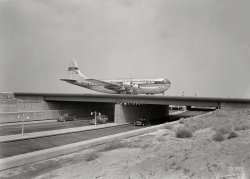
- Itchy & Scratchy: 1938
- ... zero hits. Harlem was a name from the Dutch Settlement of New Amsterdam, better known by the British name of New York.
Clue from a ... name as a horse medication in some parts (Texas and New Zealand were two places a quick web glance revealed), and is apparently juniper ... Posted by Dave - 12/10/2007 - 1:16am -
![Itchy & Scratchy: 1938 Summer 1938. Drugstore in Newark, Ohio. View full size. Photograph by Ben Shahn. Image scanned from 35mm nitrate negative.
Sal HepaticaI though he played 3rd base for the White Sox....but seriously, wouldn't it be nice if stores today posted their price so easy to read.
dss
Times sure have changedYou could get Dutch Harlem Oil Capsules for 25 cents back then. Just try finding them for less than $1 each now. And if you have to ask how much Syrup of Pepsin costs now, you can't afford it.
Itch!!!!I think the guy in the middle has a itch or something.
[Maybe he could use some J&J. - Dave]
Ron's right.Good thing the J & J talc comes in Large.
Dutch Harlem OilSounds like an Eddie Murphy movie. Wonder what it was? Google has zero hits. Harlem was a name from the Dutch Settlement of New Amsterdam, better known by the British name of New York.
Clue from a 1936 newspaper below - Dave
Haarlem OilHaarlem seems to have been the more popular spelling as judged by hits in the newspaper archive. From 1940:
Juniper berry oil or tarHaarlem Oil seems to be still used under that name as a horse medication in some parts (Texas and New Zealand were two places a quick web glance revealed), and is apparently juniper berry oil or tar.
This site has an article from 1908 about how the Pure Food & Drug Act prevented the manufacture of domestic (U.S.) Haarlem Oil.
Here's a link to someone selling a vintage box of Gold Medal Haarlem Oil on eBay for $3.99. Alas, it appears the box is empty. No kidney relief in sight...
why I love photographyThis slice of life--as perfectly preserved as a lab slide--captures a reality long long gone. What can you get at a pharmacy now for a quarter? Also preserved for eternity, that hapless man, scratching his balls.
Some things never change.
I RememberMy grandfather used to buy Pepsin tablets not the syrup. They came in little brown bottles and were itty bitty little things.
Some Mighty Expensive Baby Talc There.Har har har! I just realized that they are offering a choice of 24¢ or 49¢ worth of Alka Seltzer. At first, I thought that the dot in the middle was a decimal point. Even by today's standards, $24.49 for a couple of Alka Seltzer tablets would be considered a bit pricey.
It just might be……24 tablets for 49¢
[Each number is a price in cents. For example Sal Hepatica in three sizes: 24, 49 and 97 cents. - Dave]
Itchy and Scratchy Indeed...The two men leaning aganist the building look like they could be brothers.
Town Hall TonightThe first thing this made me think of was that, in the 30s, "Town Hall Tonight," starring Fred Allen, was sponsored by the makers of Ipana and Sal Hepatica.
The second thing I thought was, "What was quinine hair tonic, and how long did it take to use up a pint?"
(The Gallery, Ben Shahn, Stores & Markets)](https://www.shorpy.com/files/images/8a18407u.thumbnail.jpg)
- City Gas: 1912
- ... (mercaptans) is used so a leak can be detected. I visited New Zealand in the 1980s, and Christchurch, Invercargill and Dunedin were still ... Posted by Dave - 10/21/2014 - 9:30am -

- Crank Call: 1940
- ... 20 year process finally completed in 1960.
A visit to New Zealand in 1985 revealed that some small towns still had not received dial ... Posted by Dave - 11/24/2019 - 9:15pm -
![Crank Call: 1940 April 1940. "Lady signaling operator on old-style telephone. Scranton, Iowa." Medium format acetate negative by John Vachon for the Resettlement Administration. View full size.
"Turn crank briskly ... "In October of 1975 I drove my 1965 Falcon from Vancouver, Canada, to San Francisco on a leisurely trip down the coast. I arrived at a road junction north of Fort Bragg, and saw a phone booth. I planned to stay with friends in San Francisco, and thought this was a good time to call and let them know of my arrival day. Upon entering the booth, I discovered the pay phone had no dial, and below it was a black box with a crank on it. There were detailed hand-written instructions on how to use it.
"Remove handset to be sure line is clear." There was no dial tone, and this was to determine if anyone else was using the party line. "Replace receiver, and turn crank briskly to signal operator." A male voice answered in Fort Bragg, and placed the call to San Francisco. The final instruction: "Turn crank briskly to clear the line". I charged the call to my Vancouver number, and when the bill came it read: "Call from North Rockport Toll Station No. 1."
Vancouver was one of the last large cities to convert to dial phones, a 20 year process finally completed in 1960.
A visit to New Zealand in 1985 revealed that some small towns still had not received dial telephones, as shown in this photo of a pay phone in Taihape.
I have the wheat pastebut could you bring the brushes and seam roller when you come over to help hang the wallpaper today? I have to burn some incense in the Buddha to cover up the smell from Bob's fish dinner.
Just When You ThinkIt could it get any better? Dave comes up with this caption!!! Now I have to add THIS ONE to my all time favourites list.
[Thank you! Although "Crank Call" is the title, not the caption. The caption is the writing under the photo. - Dave]
[Right! My old brain needs to reboot :) - Baxado ]
Roll CallShe has rolls of something in bundles and it seems she's calling the person she prepared them for to say they are ready. Perhaps she is making some side money. What are they?
Corner shelfI made one in wood shop class identical to that one in junior high school around 1977.
Calling up CatfishMy grandfather (b. 1898) had the innards of one of those telephones in a bucket in his fishing boat. When he was hungry for catfish, he'd load me up and we'd go out to a deep bend on the Clear Fork of the Brazos and slide the jonboat through the reeds and into the river a couple hundred feet upstream of the bend.
On one of the copper telephone wires he had tied a horseshoe as a weight, which he dropped straight down off the side of the boat. The other, much longer wire was tied to a big iron washer -- about the size of a #10 can lid. I'd paddle down to the deepest hole in the river and he would swing the washer over his head like a lasso and toss it as far as he could. As soon as the washer hit the water, he'd holler "crank it!" and I'd wind the magneto as fast as I could, creating a current between the two poles and stunning any catfish caught in between them. After a few seconds he'd get the dipnet and scoop up any electroshocked fish and we'd repeat until he had enough for a fish fry.
I later discovered this was regarded as unsporting and possibly illegal means of harvesting fishflesh. In the mid-'60s, however, I never passed up and opportunity to go "call up some catfish".
Where's the bird?She looks a lot like Granny from the Tweetie and Sylvester cartoon.
Makes me think of Bryant Pond, MaineBryant Pond was the last community in the U.S. to have crank telephones, switching over to plain vanilla dial phones in 1983.
To call my friend in Bryant Pond, I had to dial 0 and ask the operator (remember operators?) to place a call to Bryant Pond 32 -- which was my friend's number. Some operators took it in stride; others took some convincing.
Oh, my aching backI'm pretty sure her phone calls never lasted long - look at the posture she has to assume. That table makes her stand about two feet away from the phone and then lean forward over the table to get close to the mouth piece. I'm surprised I don't see a hand mark on the wallpaper from bracing oneself. And of course she'd never just clear that table and sit on top of it.
She doesn't look BuddhistSeriously, I am a little surprised by the Buddha figure on her shelf. Grandma was practicing way before it was hip!
About those rollsI'm probably wrong but, those rolls seem to me to be too narrow. Is it possible that they are player piano rolls? A couple of them seem to have narrow wooden slats along one edge. I remember seeing player pianos in one of my aunt's homes when I was a kid in the early 1950s and they generally looked like these, but were usually stored in boxes.
No hands voice dialingThat phone used no hands voice dialing, an amazing technology that is virtually unavailable today.
More!A person can never have too much wallpaper. Well, maybe sometimes.
BuddhaMy grandmother had one -- an incense burner, in green-red-gold.
Isn't It Obvious?Those rolls next to her can't be anything but more wallpaper that needs hanging!
I really like the woodworking on that fern table in front of her!
(Technology, The Gallery, John Vachon)](https://www.shorpy.com/files/images/SHORPY-8c17214a.thumbnail.jpg)
- Home Again: 1918
- ... devoted to antique sock knitting machines and a company in New Zealand that produces new sock knitting machines based upon the antique ... Posted by Dave - 08/27/2012 - 3:44pm -
![Home Again: 1918 "Army soldiers, Walter Reed Hospital." Back from the trenches in Washington, D.C., circa 1918. Harris & Ewing Collection glass negative. View full size.
An old yarnI would love to have that knitting machine!
On a side note, speaking of "women's work," my dear grandfather took up cross-stitching when recuperating after World War II. He enjoyed it immensely and found it to be very relaxing. He kept it up until his death in 2007. He would do a couple stitches on whatever he was working on each day after smoking his after lunch pipe. He made gorgeous tablecloths and other items as gifts for everyone in the family.
Stick to your knittingThe man on the left is using a circular sock knitting machine, which is a pretty cool (and rather complicated) gadget.
http://www.oldtymestockings.com/CSMMuseum.html
999 scarves left to goThe guy on the right appears to need a bit more rehab.
Thousand-yard stareLooks like the shell shock hasn't quite worn off yet.
Looks likeThey made their own robes.
Got Yarn?"Yeah I knit. You got a problem with that?"
From man's work to women's workIt seems odd that soldiers who had recently been engaged in that most masculine of work--war--should have been given women's work to do in their recuperation. It could have been either very soothing or very humiliating.
Smoke Em if You Got EmCheck out the burning cigarette by the young lady.
Women's work?If you look at the history of knitting, it was solely men's work at one point, when it was mostly used to produce caps and stockings. Before the various knitting machines came along, there were entire villages in England devoted to knitting stockings, and then it was the work of the whole family. Only when knitting became less necessary and more of a recreational activity did it become solely women's work.
During the war, knitting was pushed on everyone, regardless of age or gender, as a way to help the war effort. It was considered therapeutic for patients, and probably wasn't humiliating at all.
Women's Work?Tell that to Rosie Grier. And if you don't know who Rosie is, Google him.
[And if that doesn't work, try googling Rosey Grier. - Dave]
WeightyWhat were the hanging weights for? Maybe to keep tension on the yarn?
Heavy KnittingWhen you are using either a sock (shown) or flatbed knitting machine, you use weights to pull on, or tension, the already knit material. It keeps the knitted stitches out of the way of the ones currently on the needles. There are groups solely devoted to antique sock knitting machines and a company in New Zealand that produces new sock knitting machines based upon the antique machines.
http://autoknitter.com/
Knitting as therapyKnitting and other needle crafts were widely used as occupational therapy during both World Wars. It also was used in refugee camps in Asia Minor (according to one of my old needlework magazines) as a coping mechanism for children, to soothe them and get them to calm down. Speaking as a knitter/tatter/seamstress/etc, I find most forms of needle crafts very soothing.
And logistically it is a great choice as needles and yarn are portable and don't take up lots of storage space (unless you have a stash as large as mine).
(The Gallery, D.C., Harris + Ewing, WWI)](https://www.shorpy.com/files/images/11254a_1.thumbnail.jpg)
- Honolulu Clipper: 1939
- ... the Pacific Clipper. It was en route from Honolulu to New Zealand when war broke out in the Pacific in December 1941. Rather than return ... Posted by Dave - 02/10/2015 - 2:57pm -
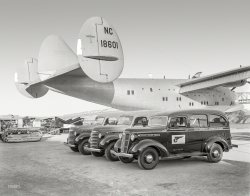
- Brooklyn Public: 1941
- ... Public Library (Ingersoll Memorial), Prospect Park Plaza, New York." Acetate negative by Gottscho-Schleisner. View full size.
The ... being built in the US, Great Britain, Australia, New Zealand and Canada. Almost 60 years after I first set foot in my local library ... Posted by Dave - 09/13/2011 - 1:59pm -
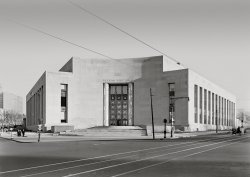
- Wonder Women: 1942
- ... drudge.
She completed her nursing training in 1939 in New Zealand and leaped at the opportunity to join the (Australian) army nursing ... Posted by Dave - 08/30/2012 - 4:48pm -
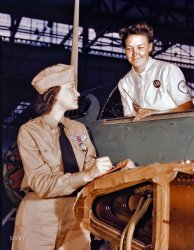
- Palm Beach: 1905
- ... myself a linguistic tuneup.
Trolleys = Go-karts In New Zealand (and probably other places) go-karts are "trolleys." There are annual ... Posted by Dave - 07/27/2012 - 4:53pm -
![Palm Beach: 1905 Florida circa 1905. "The Palm Beach 'trolley.' " Early development in the Sunshine State. 8x10 inch dry plate glass negative, Detroit Publishing Co. View full size.
Flagler hotelsThis trolley led from the the gargantuan Hotel Royal Poinciana about a half mile east to the Breakers on the ocean. Guests could also choose to take the palm-lined "Ocean Walk."
The hotel closed around 1930 and was razed in 1936. It was the largest wooden structure in the world when it was built.
http://royalpoincianahotel.blogspot.com/
A quibbleis that the term "trolley" refers to the apparatus for picking up electrical power from an overhead wire, absent in this case.
[The word meant "cart." As in horse trolley. It eventually came to be applied to the apparatus drawing electrical current from overhead wires to power a trolley car. Strictly speaking, this conveyance is a horsecar. Which is why the caption puts the word trolley in quotes. - Dave]
JustificationAnother reason I visit Shorpy every day is to give myself a linguistic tuneup.
Trolleys = Go-kartsIn New Zealand (and probably other places) go-karts are "trolleys." There are annual "trolley races" all over. A friend is an organizer for one.
Flagler SystemThe trolley is owned by Henry Flagler's Florida East Coast Railroad. Flagler was the man most responsible for early real estate development and resort building in Florida, bringing all interested parties down there via his own railroad, which ran all the way to Key West, with ferry service to Havana.
HorsepowerWhatever it is, it gets around on 1 HP.
Old FloridaHaving grown up in South Miami, I'm loving this series.
Anyone who attended South Florida schools in the 1960s would know all about Henry Flagler and his railroads and hotels. If I'm ever offered a time machine, my first trip will be to South Florida and the Keys circa 1900. It's wall-to-wall concrete now even compared to when I was a kid, but the pristine, undeveloped wilderness of the area must have been stunning at the time.
(The Gallery, DPC, Florida, Horses, Streetcars)](https://www.shorpy.com/files/images/4a12557a.thumbnail.jpg)
- Japan Surrenders: 1945
- ... the United States, the United Kingdom, Canada, Australia, New Zealand, China, the Soviet Union, and France. At the time, the British, Dutch, ... Posted by Dave - 09/02/2015 - 12:30pm -
